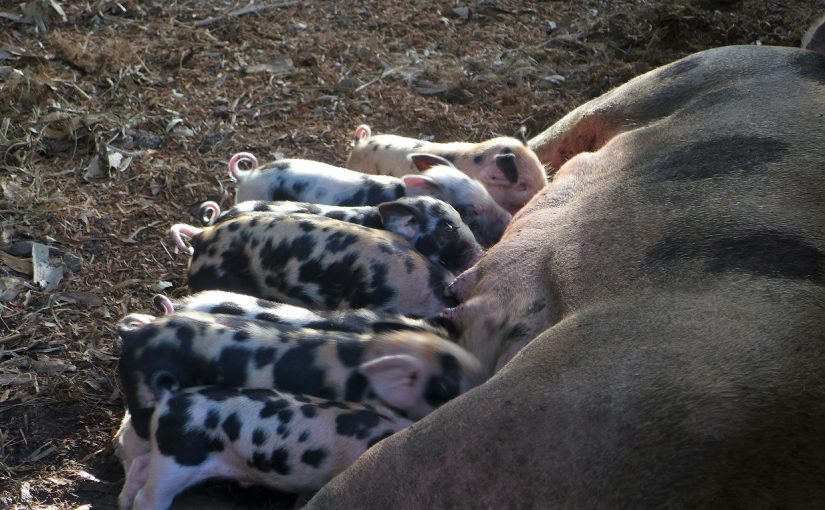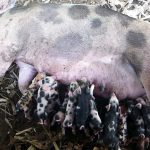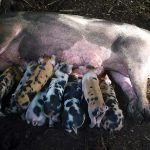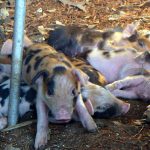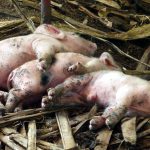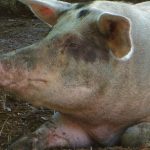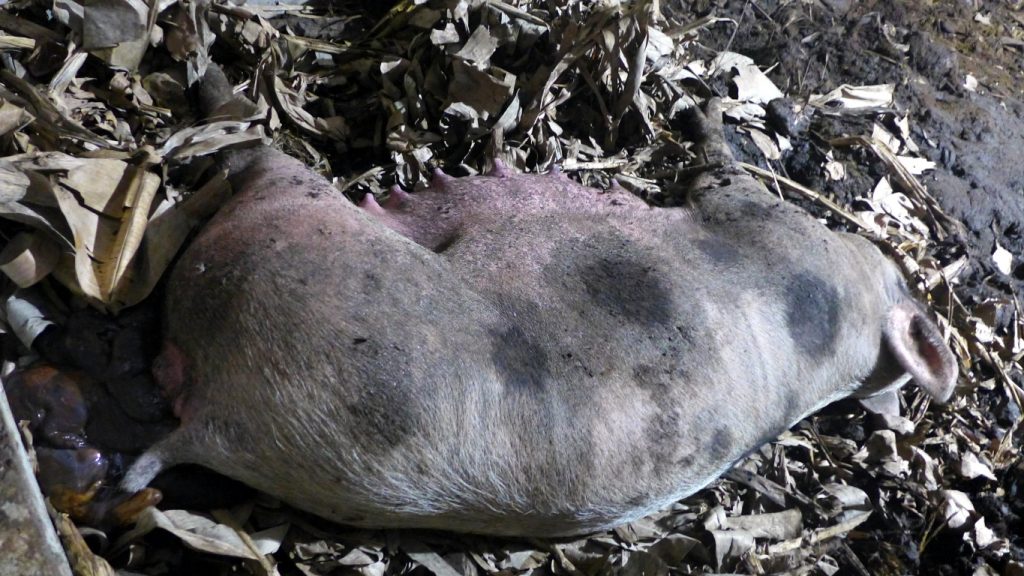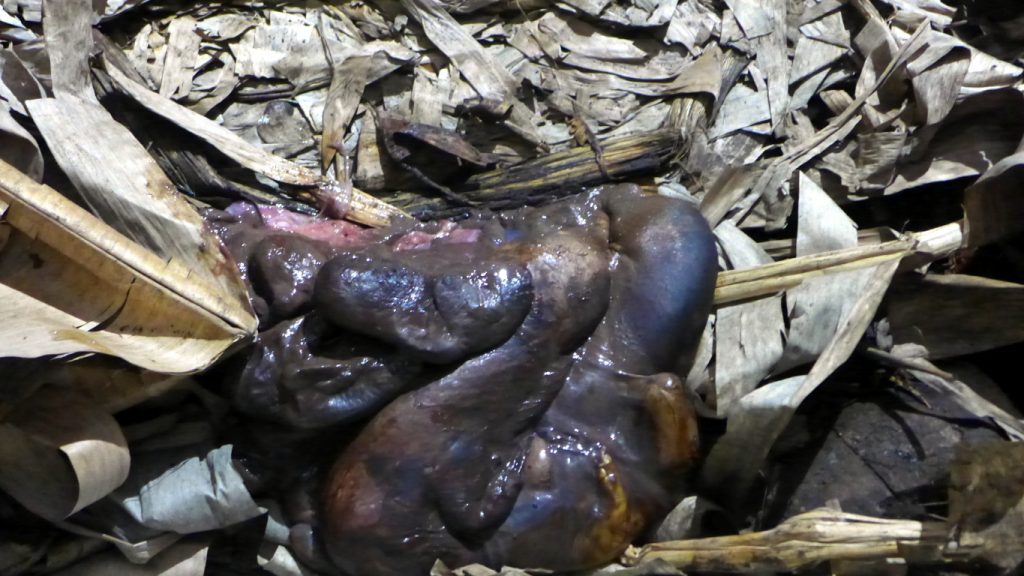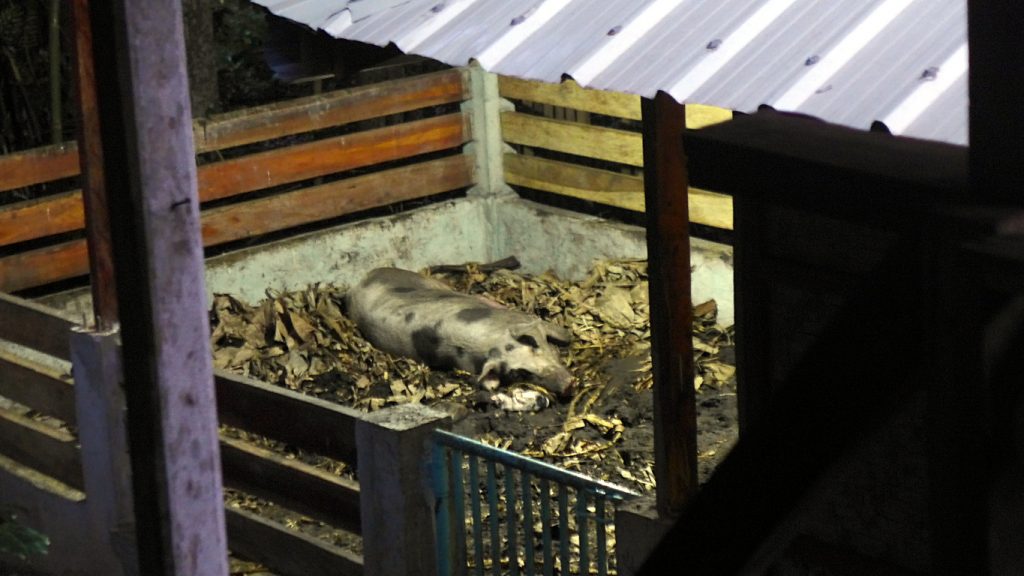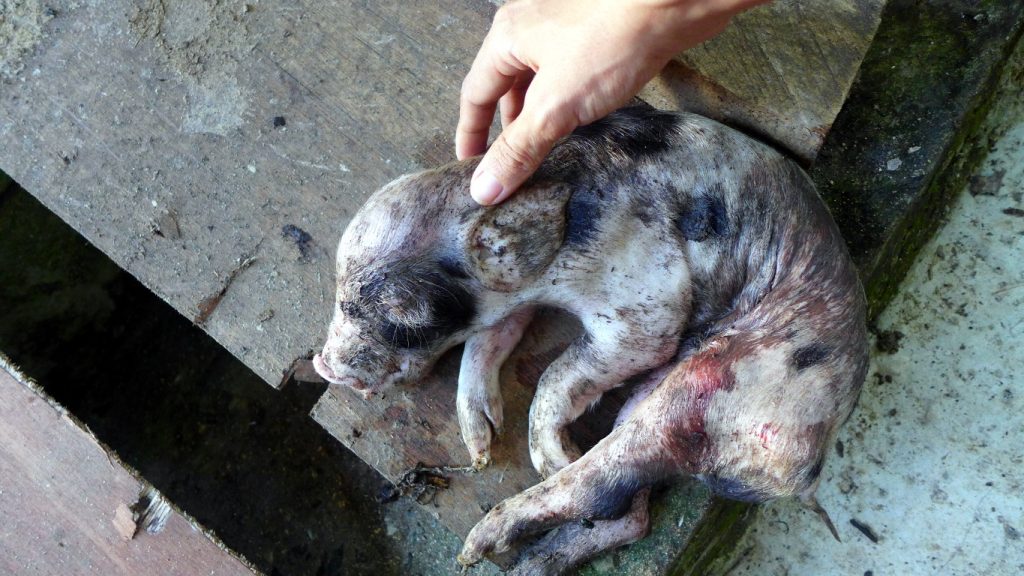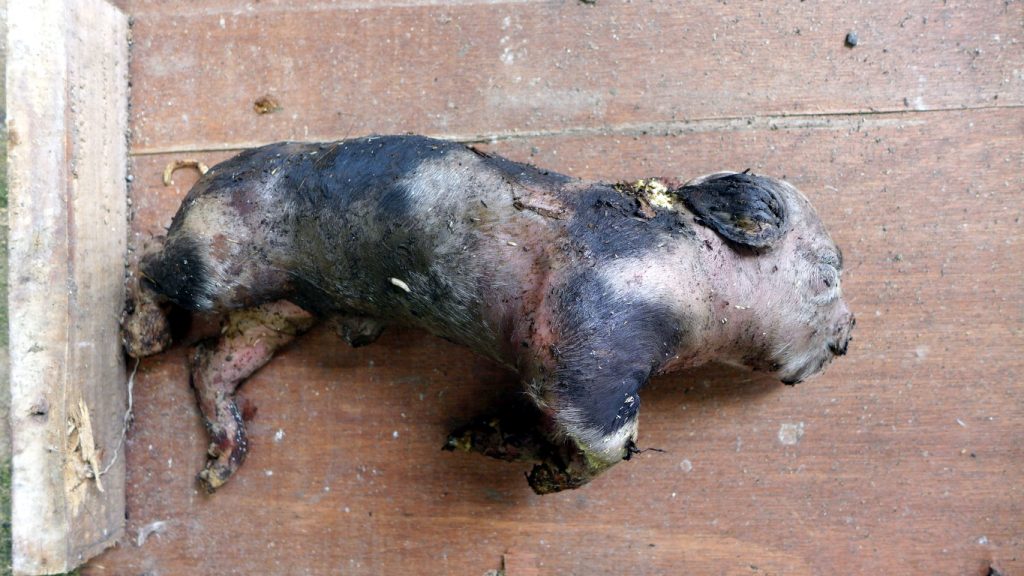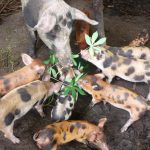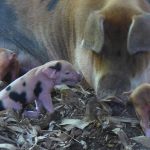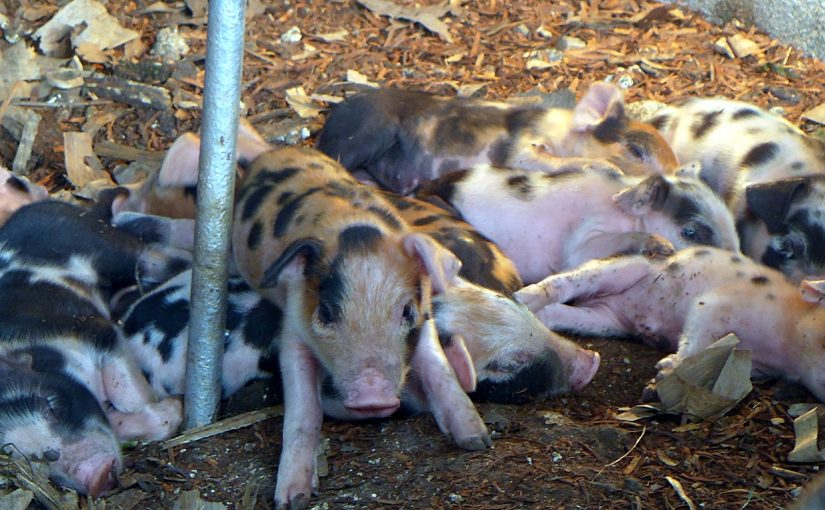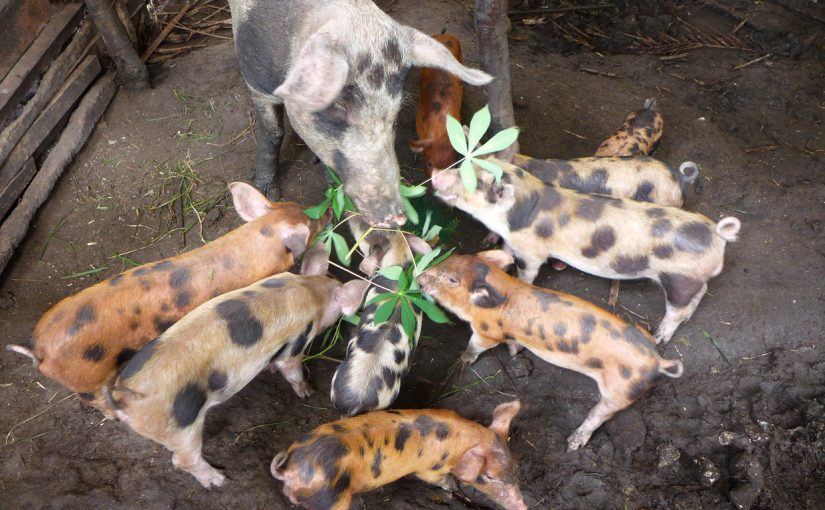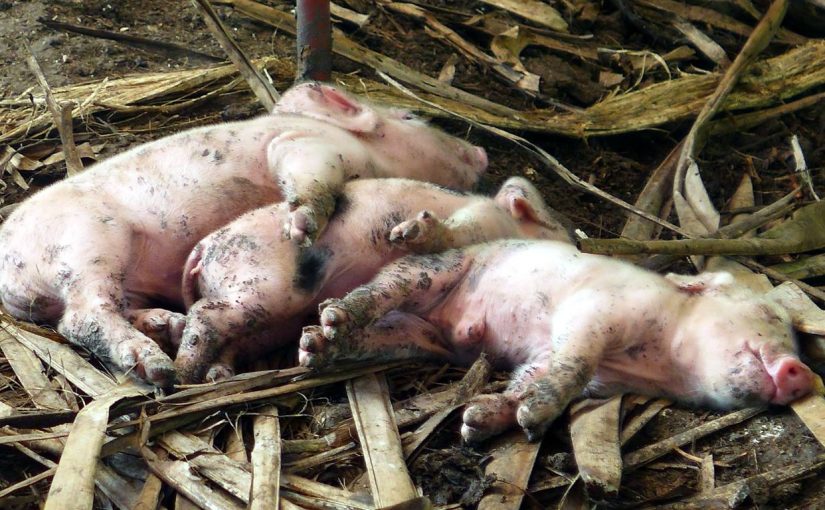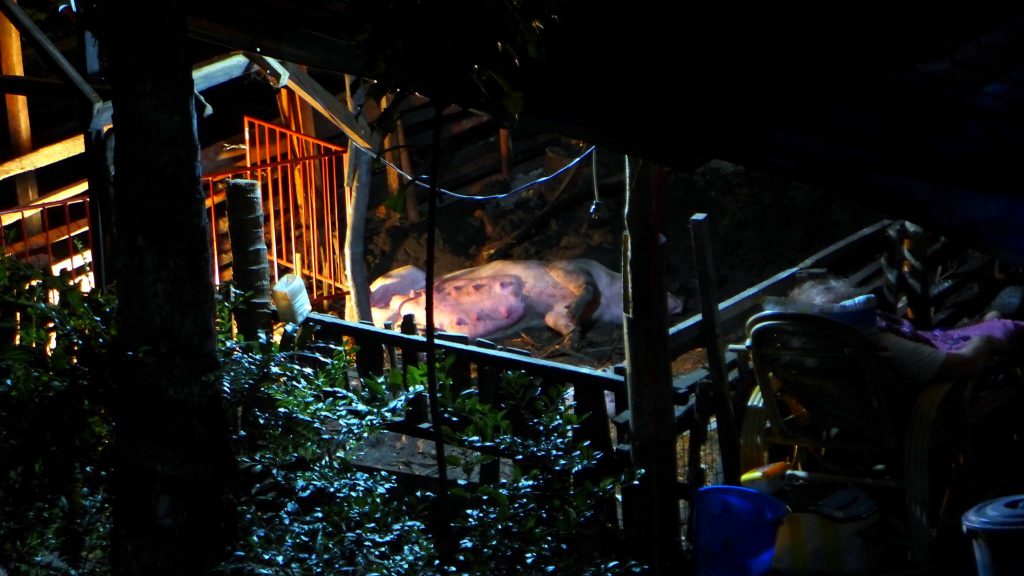Number 3 was serviced by Pinky Boar on November 13, 2017. Her expected date of farrowing was March 8 (115 days gestation). She farrowed March 9 (116 days). Number 3 has a history of farrowing on time and not earlier. This is her third parity.

First Few Hours – March 9, 2018
Around 1AM, I heard Number 3 making grunting sounds, not desperately asking for nesting material but since she usually does not grunt at this time of the night, I suspected she will be farrowing soon (12-24 hours).
At 6:10AM, our usual feeding time, a small amount of feed was given. I saw that the dry banana leaves we gave her yesterday had been put in one corner of the pen, indicating she was already exhibiting nesting behaviour in the night, thus the grunting sounds several hours ago.
7:00AM, we gave her more dry banana leaves which she collects and starts nest-building, stopping to rest every now and then, until around 10AM.
12:00 noon, I saw a couple of piglets! Farrowing must have started at least 30 minutes earlier. Number 3 farrowed along the lower right corner of the pen near the wall, her head towards us and her back along the wall, so we couldn’t see the piglets as they come out. The piglets are only partly visible through the gaps along the pigpen wall.
12:36PM, there appears to be 2 black and white piglets and 1 brown piglet, all suckling already.
1:41PM, two hours old, first sign of piglets fighting at the teats, so Number 3 starts grunting which helps stop the piglets fighting. While grunting indicates milk flow, I think it also creates strong vibrations across the teats which calms down piglet fights.
2:05PM, a rather lively piglet has started exploring the pen, then quickly returns to the mother.
2:30PM, a piglet travels even further towards the opposite side of the pen and stays there for a while, probably to urinate or defecate.
3:30PM, about 4 hours from the onset of farrowing, Number 3 gets up to eat the afterbirth, drinks water and eats about 400 grams of feeds. We counted 9 piglets born alive.
4:00PM, Number 3 lies on her right side, instead of her left side (her farrowing side) and this resulted in a lot of piglet fighting. The fighting subsides after a while. I think because Number 3 changed her first nursing position, the piglets need time to find their teats which can result in competition for teats.
Nursing takes place every hour, and Number 3 maintained this regimen for the rest of the nursing period.
Above Video: The light brown piglet climbing over the others is Humphrey. His teat is established at the first row upper left side of the mother, parallel to Panda, but he has trouble finding and attaching to it. He remains a very active piglet, but later he was the last to outgrow his scour. The black and white piglet that is unable to attach to a teat is Blackie. She gives up easily when she is unable to find her teat. She is the weakest in the litter and died due to accidental crushing. Panda is the rightmost piglet suckling. He had developmental problems but he attaches very well to his teat and grew to become one of the biggest piglets. The light brown piglet going to the mother’s head with Humphrey is Ihid and is considered the runt in the litter. He is growing fine.
Above Video: The weakest piglet, Blackie, is the focus in this video. I notice that the weakest piglets don’t engage in play and don’t actively explore the environment. Instead, they dig their snouts into the ground persistently. This is obvious even at only 2 days of age. In my experience with pigs of various ages, this persistent behaviour almost always indicated illness.
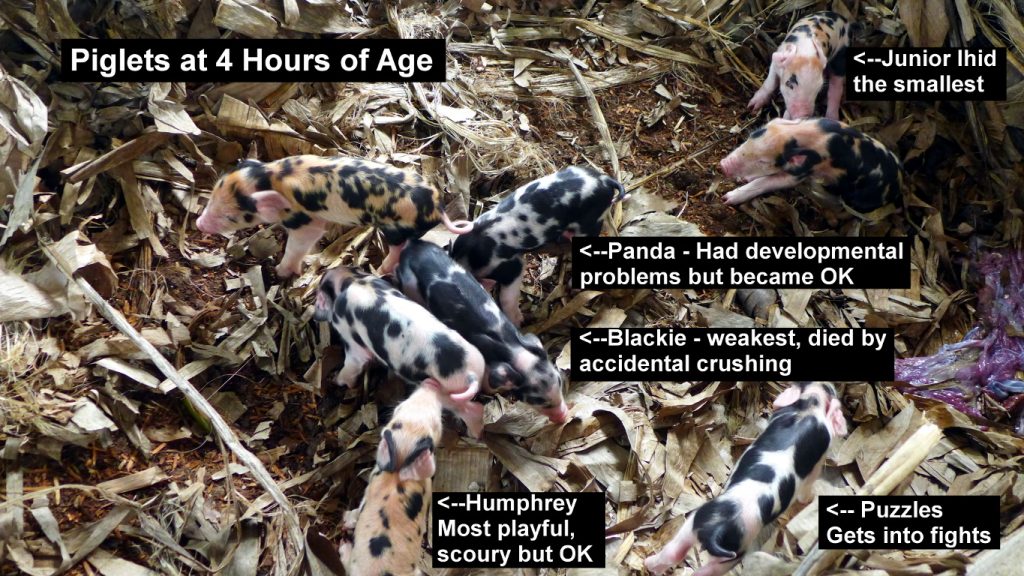
Some Observations on Farrowing
I was worried that Number 3 would have difficulty farrowing because she has a small vulva and thus possibly, a small cervix and birth canal. Interval between piglets in previous farrowing were 30-45 minutes. However, this time, farrowing was much easier and shorter intervals (5-10 minutes) between piglets. I think it might be due to the fact that this is Number 3’s third parity and because of the addition of calcium in her diet. Calcium metabolism is also fairly good since Number 3 gets plenty of sunlight and exercise.
Above Video: Piglets at 5 weeks of age. Number 3 enjoys having her piglets and at the same time knows how to discipline them when they are fighting.
Above Video: Here, Number 3 is squeezing her way into the piglet creep space so she could eat their food. Because of this situation, we have decided to build a fenced area just outside the Piglet Escape Hatch. We call it the Piglet Restaurant where piglets can eat and drink safely, away from their mother. It is fenced to prevent ducks and chickens from eating the piglet’s food.
Some Observations on Lactation, Nursing and Sow-Piglet Interaction
Above Video: At 2-3 days of age, the piglets have discovered the Escape Hatch. They begin by exploring the soil outside. Later, they go further and eat soil and vegetation. It becomes their routine to go out and play after nursing. This gives the mother the chance to rest and relax inside the pen. Later, we built a fence around this area where the piglets can escape and eat, away from the mother.
Number 3 produced a lot of milk at farrowing. By 7 days of age, milk production became insufficient because I continued giving her only gestation feeds and the lactation feeds have not arrived. When piglets fight and ask the mother for more milk that is a sign there isn’t enough milk production. I tried to rectify the problem by giving Number 3 some papaya fruits and leaves, and by giving her lactating feeds once it became available. This solved the problem in 2-3 days.
However, because of the early scarcity in milk production, fighting among litter-mates became somewhat established and piglets also developed the habit of drinking water from the mother’s trough. Piglet behaviour is developed early on and can be difficult to change. So it is important to start with good conditions.
Number 3 tries to adjust her position during nursing so all piglets have access, except when she is too tired or too relaxed to notice there is trouble amongst piglets. Number 3 also gives special attention to weaker piglets, allowing them to access her teats or continue suckling while the others are asleep.
Above Video: 3-day old piglets fighting. This is Puzzles (black and white spots) and Brownie. These piglets are next to each other at the teats and will continue to fight at the teats until weaning. The mother disciplines pigs that fight.
Number 3 disciplines naughty piglets. When there is fighting at the teats and Number 3 gets hurt, she growls, gets up and nips the piglet that is causing trouble. She actually knows who is being naughty.
Video Above: On piglet discipline, relevant behaviour is in the first 15 seconds of this video. Piglets are 17-days old in this video. In the past several days there has been much fighting at the teats because of one or two very aggressive piglets. Notice the third piglet from the left fighting with the second piglet. Number 3 gets hurt, growls and gets up, then looks for the naughty piglet and nips her. This is how Number 3 disciplines her piglets – she actually knows who is at which teat and who is being naughty. Despite much fighting such as this, Number 3 never savaged any piglets and continued to nurse them. We don’t cut any piglets teeth.
On Crushing/Laying Over
One piglet was crushed accidentally on Day 3. This was a weak piglet, perhaps unable to nurse well on the first hour of birth. The accident was partly my fault. I gave Number 3 a small bath near the trough which motivated her to lie near the trough and nurse her piglets there. That area is a dangerous place for piglets, particularly when the mother gets up for feeding time. This was the same area where the weak piglet was crushed.
Above Video: Number 3 lies in the distance, then calls her piglets to suckle. This is a great technique, reducing risk of crushing or laying over. Piglets are 9 days old here and although Humphrey has already established attachment to his teat, he still likes humping over everybody!
Since a piglet was crushed, the rest of the litter have become more wary of the mother and they try to be more careful and alert. They actually try to avoid sleeping near the trough. The mother also discipline her piglets to keep them from going between her legs or under her teats while she is about to lie down. It is obvious that the mother is aware of the dangers of crushing/laying over. Interaction between sow and piglets is crucial for them to establish communication.
Caring for a Slow, Under-Developed Piglet
One piglet we call Panda is different from the others. He is of normal size but has a somewhat bulbous head, arched back and very slow in response and perception. Initially, he had a weak suckling reflex although he does attach tenaciously to his teat. He doesn’t have the same gait as his siblings and has difficulty getting up.
Above Video: Here is Panda at 10 days of age. He has a somewhat bulbous head, a rigid gait, an arched back, and he doesn’t run around as actively as the others.
Above Video: Here, Panda has difficulty getting up while everyone else is already drinking milk!
Above Video: While piglets actively explore the garden, Panda seems to have difficulty. However, the excitement of the outdoors kept his spirits high and was daily motivated to get better. In the next couple of days, Panda progressively became better, catching up fast on his litter-mates.
Panda received Iron Drops like all his litter-mates. We don’t intervene during nursing and leave him to find his teat and develop good suckling reflex. Drinking water is provided for all piglets in an outside creep-space we call the “Piglet Restaurant.” All piglets are allowed to go out into the garden and eat soil, vegetation. Panda was the weakest but he always looked forward to going out into the garden. The outdoor exercise and abundance of soil and vegetation had a strong positive psychological influence on Panda. In fact, despite his ‘disability’, Panda was quite fierce in defending his teat from the other piglets. In 2-3 weeks, Panda is nearly as active as his litter-mates.
Above Video: 20 days old. Humphrey is a very playful piglet since the beginning. He is parallel to Panda at the teats. Early on, he developed the habit of humping Panda (and other litter-mates), thus his name. In this video, he harasses Panda and Panda squeals. The mother hears this and calls. Humphrey hears the mother and stops, to Panda’s relief, and pretends to have not done nothing wrong by rooting the ground.
Above Video: Here, the piglets are 16 days old, enjoying the garden. Panda is doing much better here and being able to go out into the garden and play has given him great psychological motivation to get better.
Some Observations on Post-Weaning
We separated Number 3 from her litter when the piglets were 45 days of age. All the piglets remained active and playful and eat well. Scour began to set in at Day 2-3 of weaning and remained up to 6 days so I decided to intervene with probiotics. The scour is grey, watery, projectile of various degrees. All piglets remain active and eat well. Piglets were also given green banana leaves. There was some improvement but scour remained. So by Day 10 I decided to give Apralyte treatment, an anti-scour formula, for 5 days.

Day 2 of anti-scour treatment, piglet scours are thicker and not as watery as before and the appetite of the piglets increased immediately. Day 3 of anti-scour treatment, the piglets began to get bigger as well. By Day 4-5, piglets are all back to normal, except for Humphrey who was the last to get rid of his scour completely.
Next time, I must include probiotics in sow/piglet water at least a week before weaning. Although the pigpen has been sprayed with Lactic Acid Bacteria solution, that didn’t seem sufficient. This batch of piglets also had less green forage because of the early provision of piglet crumble feed. We have had better cases in the past wherein piglets did not develop scouring as bad as this and they did not receive any piglet booster or crumble feed. I think next time I should implement early addition of probiotics in piglet diet before, the abundance of green forage and the late addition of any protein-rich feed (piglet booster, crumble, etc) in their diet.
Although we can look after piglets after they are born, I am getting more interested in how to make the piglets healthier while still inside the mother’s womb. Iron deficiency is one of the biggest hurdles. While I am still studying how adjustments to the mother’s diet may help, it is also possible to provide Iron rich forage and soil that piglets can nibble on as early as the first 3 days of life. The pigpen floor has more sawdust than soil, so while the Piglet Escape Hatch into the garden is crucial, I will need to put some clean soil into the pen for the piglets.
Some Observations on Extended Lactation/Nursing (up to 3 months)
Above Video: This is perhaps somewhat embarrassing but Ihid does not care! Here he is still suckling at nearly 9 weeks of age!
We allowed the runt Ihid to stay with Number 3 until he was 90 days of age. Ihid continued to suckle and the mother allowed him to do so but less frequently. Because Ihid was unable to eat well in competition with his mother he has not put on as much weight as his siblings. He developed no scouring.
However, after weaning, Ihid developed scouring after 3 days, so Apralyte treatment was given by day 5, for 3 days. Improvement is observed quickly. An acidifier, citric acid, is also added to Ihid’s water. This is now also given regularly to the adult pigs, ducks and chickens, to lower their gut ph, improve digestion, and reduce effluent. Less messy effluent also means minimized odor and easier management.
Above Video: Ihid the Runt finally weaned at nearly 3 months of age. He misses his mom. We are deciding to keep 2 piglets next time so the pigs don’t become too lonely.
Piglet Weights at Post-Weaning (55 days): 25-16 kilos. The females weigh less than the males. Panda weighed 22 kilos.
Four piglets were sold to two neighbours and three piglets were sold to an orphanage in Dauis. We keep Ihid the Runt. Although we have done this many times before, I still miss the piglets every time! I love each and every single one of them! 🙂

